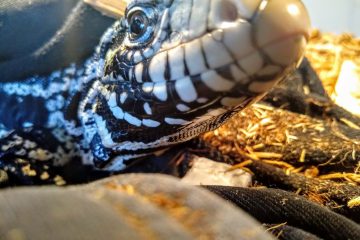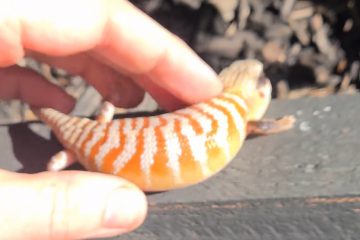原文出处:http://netvet.co.uk/lizards/cryptosporidium.htm
翻译&作者:@诚熙L19
爬天ID: daibingrain
隐孢子虫是一种作用于肠胃的寄生虫其广泛寄生于从人类到鸟类以及许多动物之间,包括牛,羊以及人类驯养的动物,当然也包括爬虫。尽管某个物种的传染更倾向于是由于单一种类的隐孢子虫所造成的-举例来说,人和牛的主要病原体是小隐孢子虫,但是他们可以受到其它隐孢子虫的影响。这就是为什么说卫生是非常重要的。
隐孢子虫病是很容易感染的-为什么这么说呢?
不同隐孢子虫的生命周期都是相同的,无论他出现在蜥蜴,羊或者人身上。尽管某些原生动物比人类的血细胞要大,但是本质上作为单细胞的隐孢子虫是要比血细胞小的。隐孢子虫是无法离开寄主生活的,它的繁殖过程相对非常复杂,在此无须多叙。它的存在形式是一种卵囊虫(也就是一包细胞核组成)进入到寄主的粪便中(译者注:有些原生动物受精后的合子会分泌一些物质把自己包住,虫体就在其中分裂繁殖,这层保护结构称为卵囊或卵囊虫。)这种形式使它们可以很幸运的活在寄主体外,事实上它们足以对抗几乎所有正常的清洁剂,包括漂白剂。卵囊虫包含有四个孢子体,这样它们可自主移动,很轻易地进入下一个寄主的肠道中,而让生命周期得以延续。现在我们还不清楚人类,蜥蜴或者其它动物吞入多少数量的卵囊虫会导致隐孢子虫的传染,但是许多权威专家说可能一个就足以。想象一下,无意中吞下一个像红细胞那么小的东西是多么的容易,也就不难知道隐孢子虫病是多么容易被传染的了。
蜥蜴n蜥蜴间的传染
隐孢子虫真菌孢子(又名卵囊虫)进入到被传染的蜥蜴的粪便中进而无限期的存活在寄主体外。在一次量大且松散的排便(见下文)过程中,成百上千的孢子被释放出来,另一只蜥蜴摄入到哪怕一个孢子的风险也是巨大的。这就是为什么当某只动物被怀疑感染隐孢子虫的时候需要单独饲养,并且使用含氨消毒水或氢氧化钠来对饲养环境(笼舍)进行消毒。除非你的饲养环境(笼舍)非常昂贵,否则我建议你推倒重来。尽管隐孢子虫已经非常严重了,但它初期显示的可能只是一般疾病的症状,当你怀疑他是隐孢子虫病的时候,这个时候你的蜥蜴已经真的病了。
不放过任何征兆
一个较晚的隐孢子虫病的信号就是一次量大,水水的,充满恶臭的腹泻,而早期的信号则是昏睡和缺乏食欲。许多蜥蜴都可以携带隐孢子虫数年而无任何症状,但是发病的时候又会十分突然,并且迅速病入膏肓。这是由于紧张或某些原疾病导致你的动物虚弱,但是大部分时候疾病到来的无缘无故。在腹泻之前(上文述),动物们可能会在极短的时间内大幅降低体重。同时,有发展成脱水状态的趋势。正如脱水后,很重要的一点就是补充液体(译者注:类体液的补充剂),如果可能的话,强制性补充从而避免器官损伤。某些蜥蜴会表现为变瘦,皮肤暗淡(如守宫类,极易感染隐孢子虫病),作为副作用的表现,肝脏变暗,我们可以观察到肝脏部位皮肤下方出现类似于淤青的蓝色斑点。其他物种的蜥蜴,可表现为整个上腹部变得肿胀且非常柔软。
如何预防隐孢子虫病
预防隐孢子虫病的三种方法卫生!卫生!卫生!(译者注:原来老外也知道重要的事情说三遍啊)尽管在寄主体外要想杀死这种寄生虫是非常困难的,但是一次周密彻底的清洁工作能最大程度的降低传染,交叉传染以及二次传染。饲养环境(或笼舍)应保证干净干燥,蜥蜴应定期检查来确保它们永远处在最佳状态,一只健康的动物是较少会被寄生虫所感染的。清理饲养环境的时候一个明智之举是佩戴手套;不要忘了,隐孢子虫也喜欢人类哟!一个好习惯就是尽量不要让其他人拿起你的蜥蜴。他们的手上可能会携带传染源,特别是这些人也是其他蜥蜴的爱好者。而那些新手,他们的指甲里虽然没有携带寄生虫,但是往往他们会笨拙的对待你的蜥蜴,而这样又会导致你的蜥蜴变得紧张,而一只紧张的蜥蜴当它们对抗隐孢子病的时候往往是属于弱势群体。
那么致病原从何而来呢?
就像其它引起动物(和人类)的疾病一样,隐孢子虫孢子也会出现在一个它们很乐于寄生的寄主身上。这包括水,牛奶,未烹饪熟的肉,当然也包括生肉,某些蜥蜴的日常饮食中。甚至素食的蜥蜴也不能排除没有风险;假如某人手上接触了含有隐孢子虫卵囊的肉,之后又没有洗手去接触蔬果,卵囊虫会很轻易的生活在蔬果表面并等待吃掉它的寄主,这样寄生的周期就会周而复始。
隐孢子虫病的治疗
这或许是个老生常谈的话题,但是时间的确是唯一的良药。对待隐孢子虫病没有特殊的药物治疗,最关键要做的就是等待当前的传染源耗尽自己或者期待患病的蜥蜴形成足够数量的抗体来击退寄生虫。这期间,蜥蜴很大程度上会不吃不喝,而让你的蜥蜴尝试吃喝是一个饲养者最大的难题。一旦你的蜥蜴从与病魔的斗争中恢复过来,一个重要的工作就是需要检查它的排泄物,并确保其中不再携带寄生虫孢子,才可以将它放回与其它蜥蜴共同生活。
译者的话:隐孢子虫可以通过粪便浮游法,湿抹片法甚至分子生物学诊断等方法来诊断(当然我们大多数爬友毕竟条件有限),但是目前尚无法区分爬虫内隐孢子虫的种别,也没有一旦发病所对应的特效药,所以还是那句话养爬养环境,以预防为主吧.
原文如下:
Cryptosporidium in Lizards
Cryptosporidium is a gastrointestinal parasite which can infest many animals across a broad spectrum from humans to birds, via cattle, sheep and domestic pets, including reptiles. Although infections in any particular species tends to be by one species of cryptosporidium – for example, the main causative organism in humans and cattle is cryptosporidium parvum, but they can be affected by others. This is why hygiene is so important.
Cryptosporidium is easy to catch – and here’s why
The life cycle of cryptosporidium is the same, whether it takes place in a lizard, a sheep or a person. The cryptosporidium is a protozoa, which is essentially a single cell which in this case is smaller than a human blood cell, although some protozoans are bigger. It can’t live outside its host, so when it is ready to breed – and that is a process so complex we won’t go into it here – it forms what is called an oocyst (which means a bag of eggs) and this is passed in the faeces. In this form it can live quite happily outside the body and in fact is resistant to almost all normal cleaning agents, including bleach. This oocyst contains four sporozoites, which can move about on their own and develop in the next gut they meet with and so the cycle continues. It is not known for sure how many – or perhaps we should say how few – oocysts need to be swallowed for the unfortunate lizard, person, bird or whatever to develop a cryptosporidium infection, but some authorities put it as low as one. Imagine how easy it would be to inadvertently swallow a single item as small as a red blood cell. Now you see why cryptosporidium is so easy to catch.
Passing from lizard to lizard
Cryptosporidium spores (another name for the oocyst) are passed in the faeces of an affected lizard and can then survive almost indefinitely outside its body. In a single bowel movement – which will be loose and profuse (see later) – many hundreds of these spores will be shed, so the likelihood of another lizard ingesting the single spore considered a risk is huge. This is why it is essential to isolate any animal which you suspect has a cryptosporidium infection and clean the environment thoroughly with ammonia or caustic soda. Unless the habitat is extremely expensive, it may be better to destroy it and start again. Although it is potentially very serious, cryptosporidium begins by showing symptoms common to many lizard ailments and only later is cryptosporidium suspected, by which time the lizard is really ill.
Signs to watch out for
A later sign of cryptosporidium is a profuse and usually watery, always foul smelling diarrhoea, but early signs are lethargy and lack of appetite. Some lizards can carry cryptosporidium for years with no symptoms, but can suddenly become very ill with it, very quickly. This is often because of stress or another underlying disease which weakens the animal but just as often it comes on for no reason at all. Before the diarrhoea starts, the animal will probably have lost a lot of weight, very quickly. It will also have a tendency to become dehydrated and as with all cases of dehydration it is important that fluids are offered and if necessary forced to prevent organ damage. In some lizards with thin, pale skins (such as geckos, which are prone to cryptosporidium) the liver, which becomes darkened as a side effect can be seen under the skin as a blue mark not unlike a bruise. In other species, the whole midsection of the animal can become very bloated and tender.
Prevention of cryptosporidium
Three ways of preventing cryptosporidium are hygiene, hygiene and hygiene. Although the parasite is very difficult to kill outside the host, a thorough washing regime does minimise infection, cross infection and re-infection very successfully. Habitats should be kept clean and dry, and the lizards should be checked regularly to make sure they are in peak condition, as a healthy animal is much less likely to fall foul of a parasite infestation. When cleaning out the habitat, it is probably a good idea to wear gloves; don’t forget, cryptosporidium likes people too! It is probably a good practice not to let other people handle your lizards. They may be carrying an infection on their hands, especially if they are other lizard enthusiasts. If they are new to lizards they may not have the parasite under their nails, but on the other hand they probably will be a little clumsy at first with the lizard and may stress it and a stressed lizard is one which is disadvantaged when it comes to fighting off cryptosporidium.
But where does it come from?
Like so many other things that cause trouble in pets (and people) cryptosporidium can be found in many places from where it can happily get into a host. These include water, milk, undercooked meat and of course raw meat, the diet of some lizards. Even vegetarians are not without risk factors; if someone handles meat with cryptosporidium oocysts on it and then handles fruit or vegetables without washing their hands, the oocysts will survive easily on the surface and wait to be eaten, when the life cycle can start all over again.
Treatment of cryptosporidium
It may seem like a cliché but time is the only cure. There is no effective medication against cryptosporidium and it is a matter of waiting until the current infection burns itself out or the sufferer forms enough antibodies to repel the parasite. During this time, the lizard is probably not eating and drinking and tempting it to do both is the difficult job facing the owner. Once the animal recovers from the bout of cryptosporidium it is important to have its faeces checked to make sure it is not still shedding the spores and until it is clear it should not be put back with other lizards.
FATGUYS特约|泰加小知识|南美蜥之饲养小知识 似狗又似猫动物园?
似狗又似猫动物园?
本视频来自油管 作者主页:m.facebook.com/fatguys 阅读更多…


